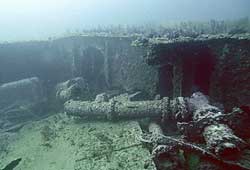

| SHIP NOTES: (Sources: Jordan, Gentile) | |
| Name: BRITISH SPLENDOUR | Type: Tanker |
| Built: 1931 by Palmers Shipbuilding & Iron, Co. Ltd.; Jarrow and Hebburn-on-Tyne |
Owner: British Tanker Co., Ltd Home Port: London, England |
| Size (ft.): 456-0 x 59-9 x 27-1 | Tonnage: 7,138 tons |
| Propulsion: diesel engine, single screws/speed 10 knots | |
| Date Sunk: 4/7/1942 | Cause: Torpedoed by U-552 |
| Location Ocracoke, NC | GPS: 34.81897N/75.90265W |
 |
 | ||
British Splendour (37)
|
|
| | |
| SHIP HISTORY: (Sources: Gentile, Hickam, Wynn) | |
| The British Splendour was making its way from Houston, TX to ultimately meet a British bound convoy off of Nova Scotia and deliver 10,000 tons of gasoline. As the tanker approached the Hatteras area, its captain was quite of aware of the potential danger and was plotting his strategy to navigate thru the area unharmed. The Splendour was not without means of protection as it was armed with a 4" gun, a 12 pound gun, a .40 mm Bofors gun and two machine guns. In addition, the tanker was being escorted by two armed trawlers — the HMS St. Zeno (FY-280) and HMS Hertfordshire (FY-176). The tanker captain decided to run as close to shore as possible following the 8 fathom line. Unfortunately, the U-552, captained by Erich Topp, by was waiting, possibly disguising itself as a blinking buoy. The tanker presented the U-552 with a perfect target setup and a torpedo was soon on its way. It struck the Splendour on the port side near the engine room killing 12 crew members. The explosion started a fire which quickly spread to the gasoline bunkers and soon the ship was ablaze. The captained ordered abandon ship and the 41 survivors took to three lifeboats and one life raft. The ship settled at its stern and continued to burn. Survivors were picked-up by the trawler St. Zeno and were taken to Norfolk. KL Topp and the U-552 continued its rampage torpedoing the Lancing, Atlas, Byron Benson, and Tamaulipas on this patrol. | |
|
|
|
| DIVE NOTES: | |||
| Diving Depths: 85-100 ft. | |||
| Current: slight to moderate | |||
| Visibility: usually in the 40-60 foot range | |||
| Summer Temperature: hi 70s | |||
| Points of Interest: High relief of the stern section and its related machinery and the striking remains of the bow; some small points of penetration in the stern; camshaft; | |||
| Fish/Animal Life: The usually NC marine animals inhabit this wreck - amberjacks, spadefish, baitfish and barracudas. I have seen many stingrays and several nursesharks on this wreck; african pompano also frequent the midwater areas above the wreck; | |||
| Description: The British Splendor appears to have landed upside down or sections rolled upside down after landing on its side as the structure twisted apart and collapsed. This is most evident when you look at the remains of the bow. The wreck contiguous with most of the relief at the stern and long flat sections amidships. It can be circumnavigated in a single dive and navigation is pretty straightforward if there is any kind of visibility and if sand hasn't covered up some of the flatter sections creating gaps. In low viz, the wide expanse of the low miship sections can be confusing if doing something much more than "hunting the edge". Much of the "interesting" structure and machinery is in the stern third of the wreck. The prevailing current seems to run from bow to stern, making the swim to the bow seemingly "endless" if you are starting at the stern. |
|
|
|
| A *very* cool 3D model/layout of the British Splendour done by NOAA Monitor Marine Sanctuary ( 35) | |
|
|
|
| PHOTOS & VIDEOS: | |
| Video tour of the bow half of the British Splendour | |
 |
|
| Diver exploring the wreckage in the engine area of the British Splendour | |
 |
|
| Looking back towards the stern (from approx. the position of the diver in the picture above) | |
 |
 |
| Crankshaft running back along the stern | Diver kneeling on the remaining hull structure - the stern disappearing in the distance to the divers right. |
 |
|
|
Bow of the British Splendour (circa 1990s)
|
|
 |
|
|
Bow of the British Splendour (circa 2018)
|
|
 |
 |
|
Remains of flow control amidships
|
Interior of the stern
|
 |
 |
|
Typical amidships structure
|
High pressure flasks in the stern interior
|
 |
|
|
Stern section
|
|
 |
 |
|
Stern interior
|
Crankshaft at stern
|
 |
 |
|
Wreckage amidships
|
Wreckage amidships
|
Unless specifically noted, all photos, text and content Copyright © 2005 by Paul M. Hudy

